

Everything is a Remix. Creative Commons. Creative Commons (CC) is a non-profit organization devoted to expanding the range of creative works available for others to build upon legally and to share.[1] The organization has released several copyright-licenses known as Creative Commons licenses free of charge to the public.

These licenses allow creators to communicate which rights they reserve, and which rights they waive for the benefit of recipients or other creators. An easy-to-understand one-page explanation of rights, with associated visual symbols, explains the specifics of each Creative Commons license. Creative Commons licenses do not replace copyright, but are based upon it. They replace individual negotiations for specific rights between copyright owner (licensor) and licensee, which are necessary under an "all rights reserved" copyright management, with a "some rights reserved" management employing standardized licenses for re-use cases where no commercial compensation is sought by the copyright owner.
Dr. Copyright. Legal concept regulating rights of a creator to their work Copyright is a type of intellectual property that gives its owner the exclusive right to make copies of a creative work, usually for a limited time.[1][2][3][4][5] The creative work may be in a literary, artistic, educational, or musical form.

Copyright is intended to protect the original expression of an idea in the form of a creative work, but not the idea itself.[6][7][8] A copyright is subject to limitations based on public interest considerations, such as the fair use doctrine in the United States. Some jurisdictions require "fixing" copyrighted works in a tangible form. It is often shared among multiple authors, each of whom holds a set of rights to use or license the work, and who are commonly referred to as rights holders.[9][10][11][12][better source needed] These rights frequently include reproduction, control over derivative works, distribution, public performance, and moral rights such as attribution.[13] History Fixing. Copyleft. Copyleft symbol Copyleft (a play on the word copyright) is the practice of using copyright law to offer the right to distribute copies and modified versions of a work and requiring that the same rights be preserved in modified versions of the work.
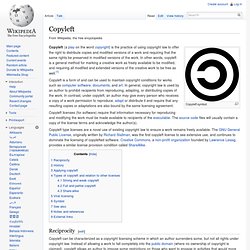
In other words, copyleft is a general method for marking a creative work as freely available to be modified, and requiring all modified and extended versions of the creative work to be free as well.[1] Copyleft is a form of and can be used to maintain copyright conditions for works such as computer software, documents, and art. In general, copyright law is used by an author to prohibit recipients from reproducing, adapting, or distributing copies of the work. In contrast, under copyleft, an author may give every person who receives a copy of a work permission to reproduce, adapt or distribute it and require that any resulting copies or adaptations are also bound by the same licensing agreement.
Reciprocity[edit] Radiohead Says: Pay What You Want. Roughly 12,000 albums are released in an average year, so the announcement late Sunday night that the new Radiohead record, In Rainbows, will be out Oct. 10 is not itself big news.

Sure, Radiohead is on a sustained run as the most interesting and innovative band in rock, but what makes In Rainbows important — easily the most important release in the recent history of the music business — are its record label and its retail price: there is none, and there is none. In Rainbows will be released as a digital download available only via the band's web site, Radiohead.com. There's no label or distribution partner to cut into the band's profits — but then there may not be any profits.
Drop In Rainbows' 15 songs into the online checkout basket and a question mark pops up where the price would normally be. Click it, and the prompt "It's Up To You" appears. Patent Absurdity — How software patents broke the system. All rights reversed. The copyleft symbol.
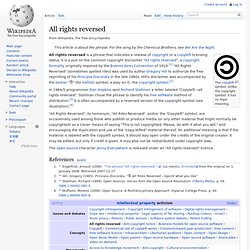
Unlike the copyright symbol, it has no legal meaning. In 1984/5 programmer Don Hopkins sent Richard Stallman a letter labeled "Copyleft—all rights reversed". Free Art License. History[edit] The license was written in July 2000 with contributions from the mailing list <copyleft_attitude April.org> and in particular with Mélanie Clément-Fontaine and David Geraud, lawyers, and Isabelle Vodjdani and Antoine Moreau, artists.

It followed meetings held by Copyleft Attitude Antoine Moreau with the artists gathered around the magazine Allotopie: Francis Deck, Antonio Gallego, Roberto Martinez and Emma Gall. They took place at "Accès Local" in January 2000 and "Public" in March 2000, two places of contemporary art in Paris.[2] In 2003, Moreau organized a session at the EOF space which brought together hundreds of authors to achieve exposure according to the principles of copyleft with this condition: "Free Admission if free work".[3] In 2005, he wrote a memoir edited by Liliane Terrier entitled Le copyleft appliqué à la création artistique.
References[edit] External links[edit] GNU General Public License. The GNU General Public License (GNU GPL or GPL) is the most widely used[5] free software license, which guarantees end users (individuals, organizations, companies) the freedoms to use, study, share (copy), and modify the software.
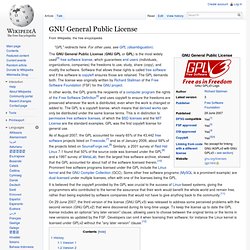
Software that allows these rights is called free software and if the software is copyleft ensures those are retained. Share-alike. WTFPL. The WTFPL (Do What the Fuck You Want to Public License) is a permissive way of licensing intellectual property rights, most commonly used as a permissive free software license.

It is essentially no different from dedication to the public domain.[2] The original Version 1.0 license, released March 2000,[3] was written by Banlu Kemiyatorn who used it for Window Maker artwork.[4] Sam Hocevar, a French programmer who was the Debian project leader from 17 April 2007 to 16 April 2008, wrote version 2.0.[5] It allows for redistribution and modification of the software under any terms – licensees are encouraged to "do what the fuck [they] want to".
The license was approved as a GPL-compatible free software license by the Free Software Foundation.[1] Beerware. Beerware is a somewhat tongue-in-cheek term for software released under a very relaxed license.
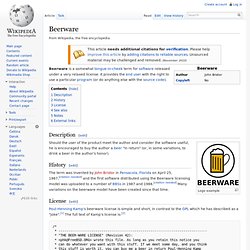
It provides the end user with the right to use a particular program (or do anything else with the source code). Description[edit] Logo example Should the user of the product meet the author and consider the software useful, he is encouraged to buy the author a beer "in return" (or, in some variations, to drink a beer in the author's honor). History[edit] The term was invented by John Bristor in Pensacola, Florida on April 25, 1987,[citation needed] and the first software distributed using the Beerware licensing model was uploaded to a number of BBSs in 1987 and 1988.
CC0 FAQ. These FAQs contain information that you should familiarize yourself with before using CC0.
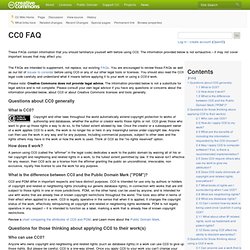
The information provided below is not exhaustive – it may not cover important issues that may affect you. Powered by Google Docs. Tasdix. Trusted timestamping. Trusted timestamping is the process of securely keeping track of the creation and modification time of a document. Security here means that no one — not even the owner of the document — should be able to change it once it has been recorded provided that the timestamper's integrity is never compromised.
The administrative aspect involves setting up a publicly available, trusted timestamp management infrastructure to collect, process and renew timestamps. History[edit] The idea of timestamping information is actually centuries old. For example, when Robert Hooke discovered Hooke's law in 1660, he did not want to publish it yet, but wanted to be able to claim priority. Classification[edit] There are many timestamping schemes with different security goals: Coverage in standards: For systematic classification and evaluation of timestamping schemes see works by Masashi Une.[1]